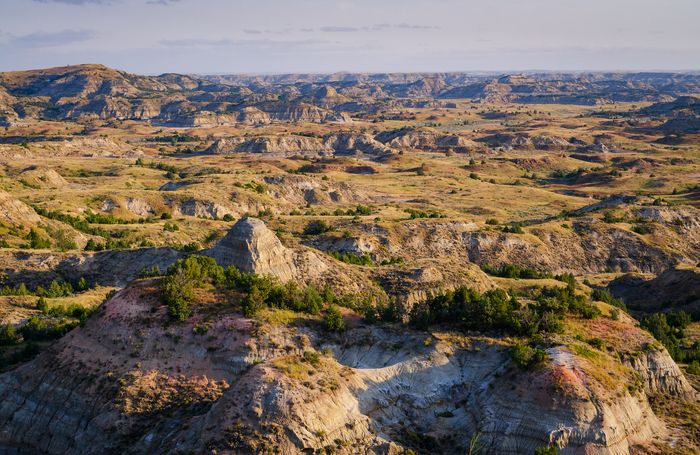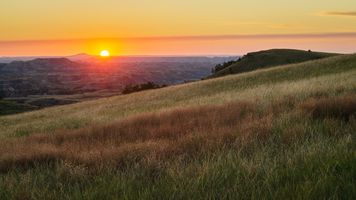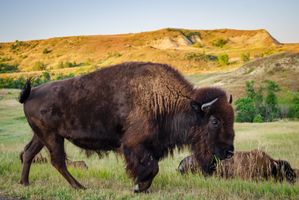Theodore Roosevelt National Park - map, photos and other informations
Table of Contents
Description
Theodore Roosevelt National Park is a stunningly beautiful and diverse park in North Dakota. Spanning 70,448 acres, it is the 19th national park to be established in the United States in 1978. The park is divided into two sections, the South Unit and the North Unit, with the Little Missouri River running between them.
Visitors to Theodore Roosevelt National Park can explore the vast prairies, rolling hills, and rugged badlands of the North Dakota wilderness. Hiking trails and scenic drives through the park offer stunning views of the landscape, including the Exlore the Maah Daah Hey trail, the Cannonball Concretions and the Oxbow Overlook.
The South Unit, which lies near the town of Medora, is the busiest area of the park and includes the popular Painted Canyon. Within this areas are trails, historic sites, camping sites, and I-94 scenic overlooks. Here, visitors can also view wild horses, bison, and elk grazing on the plains. There are also two visitor centers in the South Unit, one at the entrance of the park and one at the town of Medora.
The North Unit — located about 85 miles away from Medora — is a much more remote area and is known for its scenic drives and abundant wildlife. Many visitors come to the North Unit for the sheer number of possibilities for exploration, with trails ranging from two to 13 miles in length. Popular courses include the Elkhorn Loop, which features views of the Little Missouri River, and the Juniper Campground Trail, which is full of steep hills and rock formations.
In addition to the activities, Theodore Roosevelt National Park is packed with fascinating history. Theodore Roosevelt, the 26th US president, spent time here in the late 1880s and found its isolated beauty captivating. Roosevelt wrote often about his experiences in the area, and the park was established to commemorate his life and times.
On top of its amazing landscapes and fantastic wildlife, Theodore Roosevelt National Park also offers a unique selection of flora and fauna that makes it stand out from other national parks. Along with a multitude of prairie grasses and shrubs, the park also features two of the rarest trees in North America — the mountain mahogany and the western juniper.
The park also boasts an array of birds and birdwatching opportunities. There are over 200 species of birds in the park, including the peregrine falcon, bald eagle, and other interesting species. Birders come to the park to enjoy the birds and the beautiful surroundings.
Theodore Roosevelt National Park is an amazing place to explore the beauty and history of the Badlands of North Dakota. With its vast trails and wide variety of wildlife and plants, it is an ideal destination for nature-lovers.
Photos of Theodore Roosevelt National Park
Frequently Asked Questions (FAQ) about Theodore Roosevelt National Park
Where is Theodore Roosevelt National Park located?
Theodore Roosevelt National Park is located in three units in North Dakota. One unit is in the South Unit, located approximately 70 miles west of Bismarck-Mandan and 30 miles west of the town of Medora. The second unit is in the North Unit and is located approximately 60 miles north of the town of Watford City and 70 miles east of Williston. The third unit is in the Elkhorn Unit, located approximately 120 miles west of Bismarck-Mandan.
What to do and see in Theodore Roosevelt National Park?
Theodore Roosevelt National Park offers activities like wildlife viewing, horseback riding, hiking, and camping. Visitors can explore the South Unit’s scenic loop drive, the North Unit’s Little Missouri River area, and the Elkhorn Ranch Unit’s historic structures. Other popular sights in the park include the 36-foot overlook on top of the Chalky Buttes, the Maltese Cross Cabin, and the Painted Canyon Visitor Center.
Are there bears in Theodore Roosevelt National Park?
Yes, Theodore Roosevelt National Park is home to North American black bears, as well as a variety of other wildlife.
Are dogs allowed in Theodore Roosevelt National Park?
No, dogs are not allowed on hiking trails within the National Park. However, dogs are allowed in the parking lots, visitor centers, and picnic areas. Leashed dogs are allowed on the park's Scenic Loop Drive.
Average weather in Theodore Roosevelt National Park
|
|
|
|
|
|
|---|---|---|---|---|
| Jan | -2 °C 28 °F | -11 °C 12 °F | 2 mm 0.1 in | 7 mm 0.3 in |
| Feb | -2 °C 28 °F | -12 °C 10 °F | 2 mm 0.1 in | 9 mm 0.4 in |
| Mar | 7 °C 45 °F | -5 °C 23 °F | 6 mm 0.2 in | 10 mm 0.4 in |
| Apr | 11 °C 52 °F | -1 °C 30 °F | 24 mm 0.9 in | 16 mm 0.6 in |
| May | 18 °C 64 °F | 7 °C 45 °F | 72 mm 2.8 in | 2 mm 0.1 in |
| Jun | 25 °C 77 °F | 13 °C 55 °F | 61 mm 2.4 in | 0 mm 0.0 in |
| Jul | 29 °C 84 °F | 17 °C 63 °F | 42 mm 1.7 in | 0 mm 0.0 in |
| Aug | 28 °C 82 °F | 16 °C 61 °F | 51 mm 2.0 in | 0 mm 0.0 in |
| Sep | 22 °C 72 °F | 11 °C 52 °F | 50 mm 2.0 in | 0 mm 0.0 in |
| Oct | 12 °C 54 °F | 3 °C 37 °F | 30 mm 1.2 in | 6 mm 0.2 in |
| Nov | 4 °C 39 °F | -5 °C 23 °F | 5 mm 0.2 in | 10 mm 0.4 in |
| Dec | -2 °C 28 °F | -11 °C 12 °F | 1 mm 0.0 in | 13 mm 0.5 in |
Other parks nearby
-
Sully Creek State Park6.8 mi (10.9 km)|state park
-
Little Missouri State Park52.7 mi (84.9 km)|state park
-
Makoshika State Park58.5 mi (94.1 km)|state park
-
Fort Union Trading Post National Historic Site76.3 mi (122.8 km)|national historic site
-
Medicine Rocks State Park80.3 mi (129.2 km)|state park
User Reviews
Share your experience! Your honest feedback helps others make informed decisions.
Login to add new review




